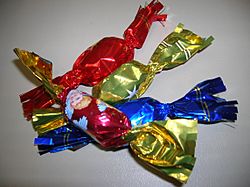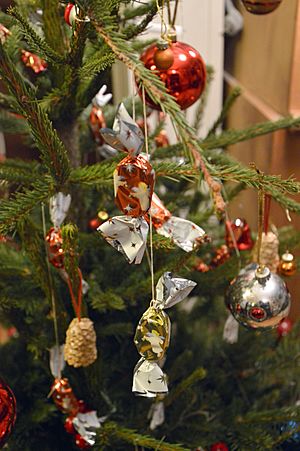Szaloncukor facts for kids
 |
|
| Type | Confectionery |
|---|---|
| Place of origin | Hungary |
| Main ingredients | filling such as jelly, marzipan, coconut covered in chocolate |
Szaloncukor (pronounced sah-lon-tsoo-kor) is a special sweet candy. It's a big part of Christmas in Hungary, Romania, and Slovakia. This candy is a type of Hungarikum, which means it's a unique Hungarian treasure.
Szaloncukor is usually made from a soft, sugary filling called fondant. This filling is then covered in delicious chocolate. Each candy is wrapped in bright, shiny colored foil. People hang these pretty candies on their Christmas trees as decorations.
During the Christmas season, families in Hungary eat a lot of Szaloncukor. They consume about one and a half kilograms per household! The tradition of hanging these candies on Christmas trees began in the 1800s. The name szaloncukor means "parlour candy." This is because Christmas trees used to be placed in the szalon (parlour or living room) of homes. Cukor means "sugar" or "candy" in Hungarian.
Contents
How Szaloncukor is Made
Making Szaloncukor used to be a completely manual process. This means people made each candy by hand. Later, machines were invented to help. The first machines were made by the Stühmer chocolate factory. They helped make the fondant filling.
Even with machines, some parts of making Szaloncukor were still done by hand. For example, the special way the ends of the paper wrapper are twisted. This twist gives the candy its unique shape.
Flavors and Decorations
When Szaloncukor first became popular, it only came in a few flavors. These included simple tastes like vanilla and strawberry. Today, you can find many different flavors! Some popular ones are jelly, coconut, and hazelnut.
People hang Szaloncukor on their Christmas trees using strings or small metal hooks. It's a fun tradition for kids to secretly unwrap and eat the candies from the tree. They often leave just the empty wrappers hanging!
The History of Szaloncukor
The idea for this type of fondant candy started a long time ago. It first appeared in France in the 1300s. Back then, it was called fondantcukor. Over many years, the recipe changed and improved. In the 1600s, a French chef named Pierre-Andre Manion brought the fondantcukor recipe to Germany.
The sweet candies became popular in Hungary in the 1800s. German craftspeople moved to Hungary and brought the tradition with them. Wealthy German families would decorate their Christmas trees with these sweets. They wrapped them in shiny paper and placed the trees in their living rooms, or "salons."
In 1891, a Hungarian-French chef named Hegyesi Joseph gave the candy its current name, Szaloncukor. This name came from the German "Salonzuckerl," which also meant "sugar in salons."
Mass Production and Factories
By 1883, machines powered by steam started making fondant candies in Hungary. These machines helped produce many candies quickly. They were often made for famous sweet shops, like the Gerbeaud brand.
Inspired by Gerbeaud, the Kugler family started their own chocolate factory in 1886. Both the Gerbeaud and Kugler families had their own special recipes. They even published cookbooks with their candy recipes in the late 1800s. At that time, the candies were wrapped in shiny tinfoil balls and colorful tissue papers.
In 1941, the Kuglers opened the largest chocolate factory in Hungary. Another factory, DEVA, was founded in 1951 in Czechoslovakia (now Slovakia). DEVA became well-known for making chocolate Christmas candies, including salónky, which is the Slovak name for Szaloncukor.


